engine OLDSMOBILE CUTLASS 1997 Workshop Manual
[x] Cancel search | Manufacturer: OLDSMOBILE, Model Year: 1997, Model line: CUTLASS, Model: OLDSMOBILE CUTLASS 1997Pages: 353, PDF Size: 16.72 MB
Page 227 of 353
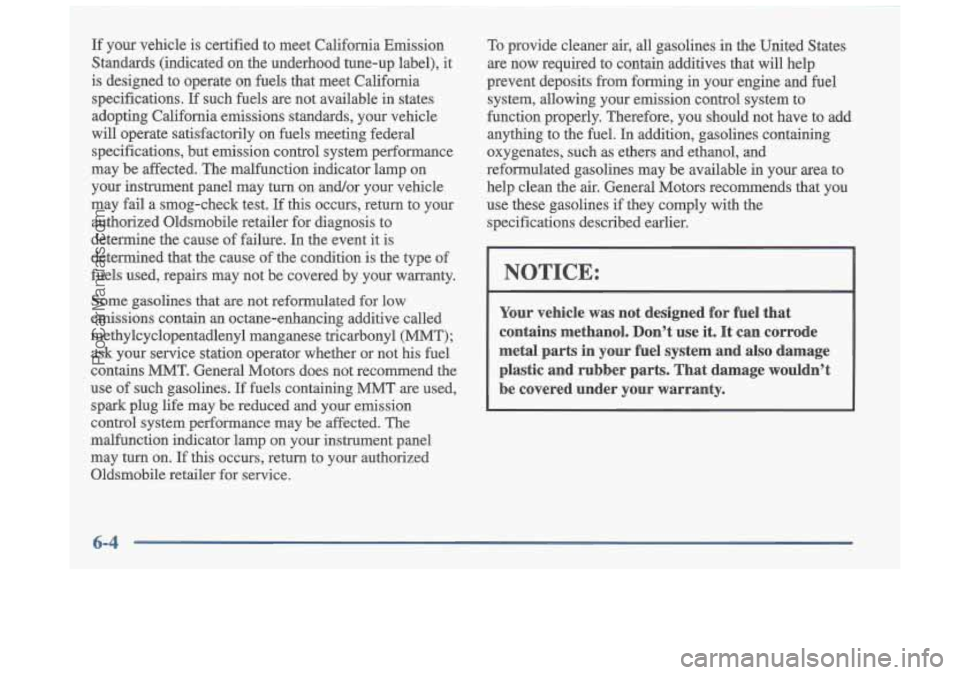
If your vehicle is certified to meet California Emission
Standards (indicated on the underhood tune-up label), it
is designed to operate on fuels that meet California
specifications.
If such fuels are not available in states
adopting California emissions standards, your vehicle
will operate satisfactorily on fuels meeting federal
specifications, but emission control system performance
may be affected. The malfunction indicator lamp on
your instrument panel may turn on andor your vehicle
may fail a smog-check test.
If this occurs, return to your
authorized Oldsmobile retailer for diagnosis to
determine the cause of failure.
In the event it is
determined that the cause of the condition is the type
of
fuels used, repairs may not be covered by your warranty.
Some gasolines that are not reformulated for low
emissions contain an octane-enhancing additive called
methylcyclopentadlenyl manganese tricarbonyl
("T);
ask your service station operator whether or not his fuel
contains MMT. General Motors does not recommend the
use of such gasolines. If fuels containing MMT are used,
spark plug life may be reduced and your emission
control system performance may be affected. The
malfunction indicator lamp on your instrument panel
may turn on.
If this occurs, return to your authorized
Oldsmobile retailer for service. To
provide cleaner
air, all gasolines in the United States
are now required to contain additives that will help
prevent deposits from forming in your engine and fuel
system, allowing your emission control system
to
function properly. Therefore, you should not have to add
anything to the fuel.
In addition, gasolines containing
oxygenates, such as ethers and ethanol, and
reformulated gasolines may be available in your area to help clean the air. General Motors recommends that you
use these gasolines if they comply with the specifications described earlier.
s
NOTICE:
Your vehicle was not designed for fuel that
contains methanol. Don't use it. It can corrode
metal parts in your fuel system and also damage
plastic and rubber parts. That damage wouldn't
be covered under your warranty.
6-4
ProCarManuals.com
Page 230 of 353
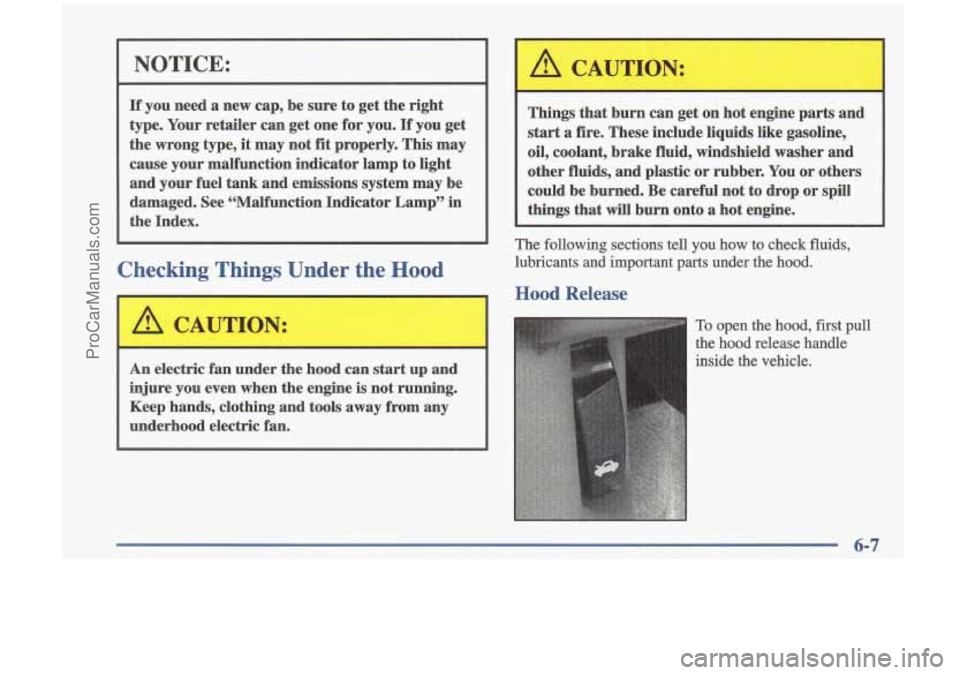
NOTICE:
If you need a new cap, be sure to get the right
type. Your retailer can get one
for you. If you get
the wrong type, it may not fit properly. This may
cause your malfunction indicator lamp to light and your fuel tank and emissions system may be
damaged. See “Malfunction Indicator Lamp” in
the Index.
Checking Things Under the Hood
An electric fan under the hood can start up and
injure you even when the engine
is not running.
Keep hands, clothing and tools away from any
underhood electric fan. Things
that burn can get on hot engine parts and
start a fire. These include liquids like gasoline,
oil, coolant, brake fluid, windshield washer and
other fluids, and plastic or rubber. You or others
could be burned. Be careful not to drop
OF spill
things that will burn onto a hot engine.
The following sections tell you how to check fluids,
lubricants and important parts under the hood.
Hood Release
To open the hood, first pull
the hood release handle
inside the vehicle.
ProCarManuals.com
Page 232 of 353
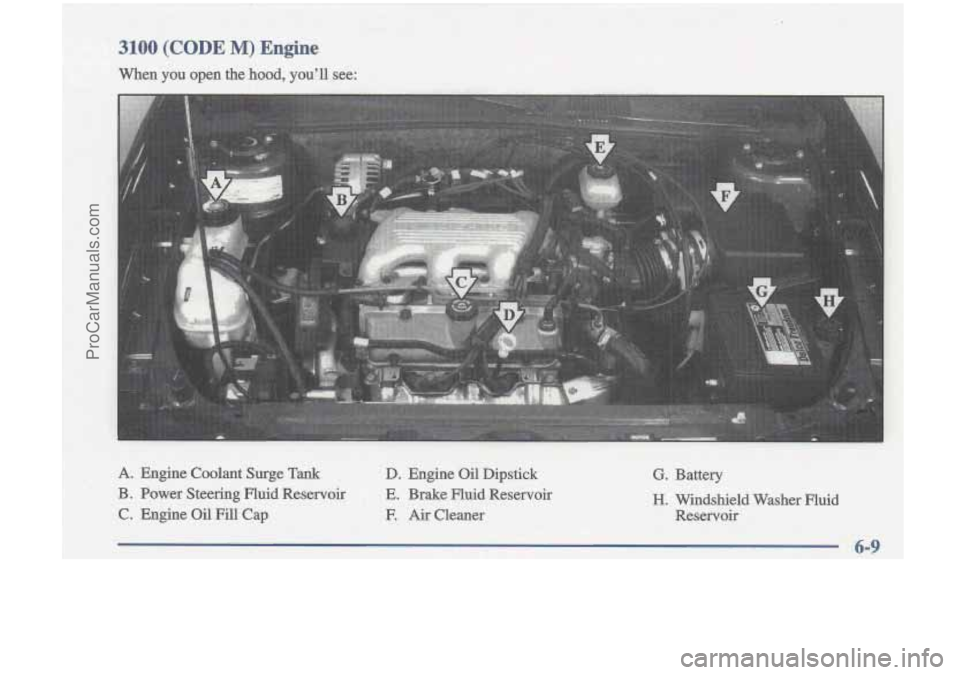
3100 (CODE M) Engine
When you open the hood, you'll see:
I A.. Engine Coalant Surge Tank D. Engine Oi€ Dipstick G. Battery
B. Power Steering Fluid Reservoir E. Brake Fluid Reservoir
C. Engine Oil Fill Cap E Air Cle,aner Reservoir
H. Windshield Washer Fluid
I'
ProCarManuals.com
Page 233 of 353
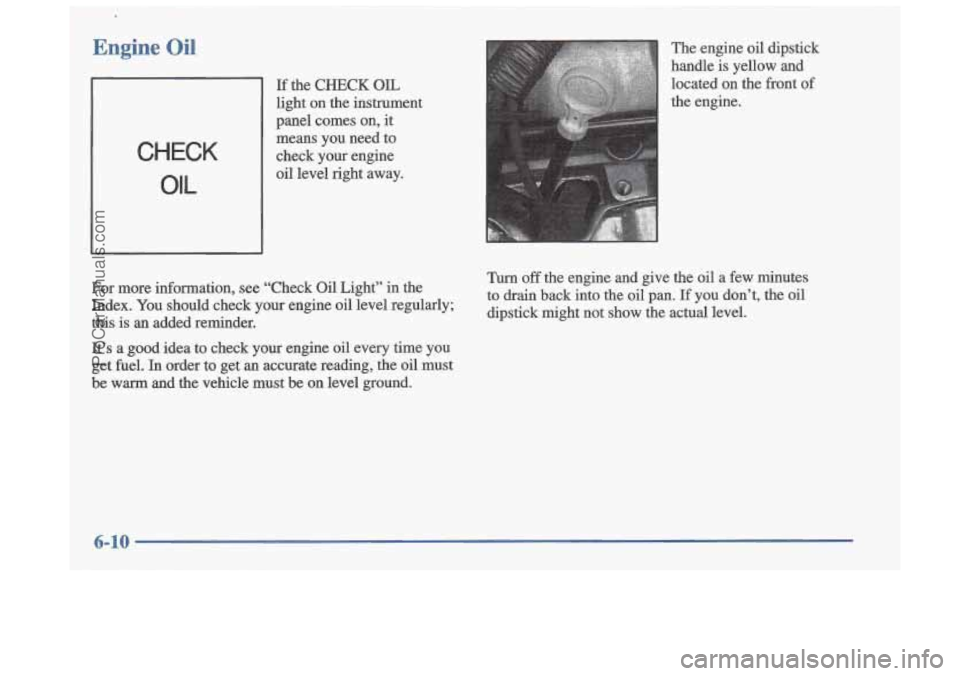
Engine Oil
CHECK
OIL
If the CHECK OIL
light on the instrument
panel comes on, it
means you need to
check your engine oil level right away.
For more information, see “Check Oil Light” in the
Index. You should check your engine
oil level regularly;
this is an added reminder.
It’s
a good idea to check your engine oil every time you
get
fuel. In order to get an accurate reading, the oil must
be
warm and the vehicle must be on level ground.
The engine oil dipstick
handle is yellow ,and
located on the front of
the engine.
Turn off the engine and give the oil a few minutes
to drain back into the oil pan.
If you don’t, the oil
dipstick might not show the actual level.
ProCarManuals.com
Page 234 of 353
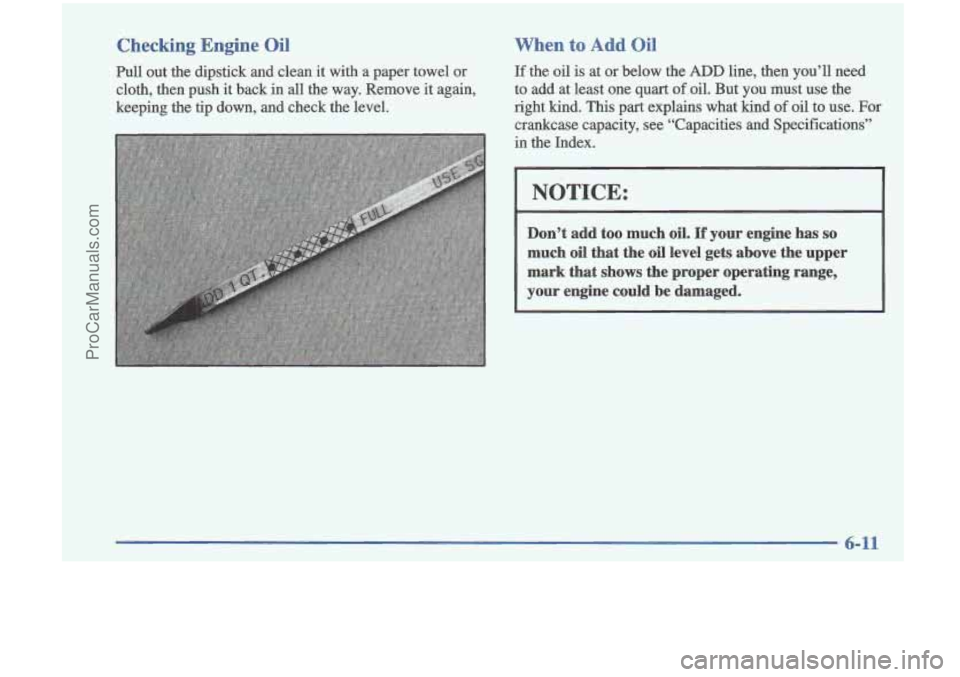
Checking Engine Oil
Pull out the dipstick and clean it with a paper towel or
cloth, then push
it back in all the way. Remove it again,
keeping the tip down, and check the level.
When to Add Oil
If the oil is at or below the ADD line, then you’ll need
to add at least one quart
of oil. But you must use the
right kind.
This part explains what kind of oil to use. For
crankcase capacity, see “Capacities and Specifications”
in the Index.
NOTICE:
Don’t add too much oil. If your engine has so
much oil that the oil level gets above the upper
mark that shows the proper operating range,
your engine could be damaged.
ProCarManuals.com
Page 235 of 353

What Kind of Oil to Use
The oil fill cap for the 3 100 engine is located on the
front of the engine.
Be sure to
fill it enough to put the level somewhere in
the proper operating range. Push the dipstick all the way
back in when you’re through. Oils recommended
for your vehicle can be identified by
looking for the “Starburst” symbol.
This symbol
indicates that the oil has been certified by the American
Petroleum Institute (API).
Do not use any oil which
does not carry this Starburst symbol.
If you change your own oil,
be sure you use oil that has
the Starburst symbol on the front of the oil container. If
you have your oil changed
for you, be sure the oil put
into your engine is
American Petroleum
Institute certified for
gasoline engines.
You should also use the proper viscosity oil for your
vehicle,
as shown in the following chart:
6-12
ProCarManuals.com
Page 236 of 353

RECOMMENDED WE VISCOSITY GRADE ENGINE OllS
FOR BEST NE1 ECONOMY J\ND COLD SIARTINS, SELECT THE LOWEST
SAE VISCOSITY "WDL OIL FOR TWE EXPEMEa'TEMPERATURE RRNSE:
HOT
WEATHER r
"F
ClOO,
+BO.
+60-
+40-
+20-
0-
f
7
"C
- +38
- +27
- + 16
. +4
--7
.-18
i
I
/
LOOK
FOR MIS
SYMBOL
SAE 5W-30 PREFERRED
WEATHER
DO NOT USE SAE 2OW-50 OR ANY OTHER
GRADE OIL NOT RECOMMENDED
NOTICE:
GM Goodwrench@ oilmeets all the requirements for
your vehicle.
Engine Oil Additives
Don't add mything to your oil. Your Oldsmobie retder is
ready to advise if you think something should be added.
ProCarManuals.com
Page 237 of 353
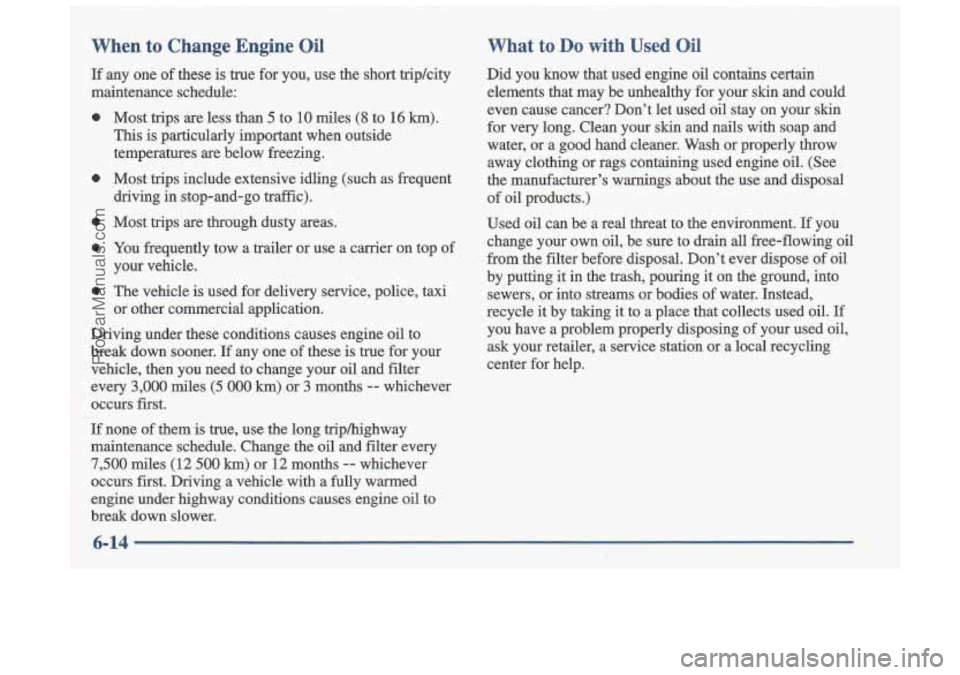
When to Change Engine Oil
If any one of these is true for you, use the short triphity
maintenance schedule:
0
0
0
0
0
Most trips are less than 5 to 10 miles (8 to 16 km).
This is particularly important when outside
temperatures are below freezing.
Most trips include extensive idling (such as frequent driving in stop-and-go traffic).
Most trips are though dusty areas.
You frequently tow a trailer or use a carrier on top of
your vehicle.
The vehicle is used for delivery service, police, taxi
or other commercial application.
Driving under these conditions causes engine oil to
break down sooner.
If any one of these is true for your
vehicle, then you need to change your oil and filter
every
3,000 miles (5 000 km) or 3 months -- whichever
occurs first.
If none of them is true, use the long triphighway
maintenance schedule. Change the oil and filter every
7,500 miles (12 500 km) or 12 months -- whichever
occurs first. Driving a vehicle with a fully warmed
engine under highway conditions causes engine oil to
break down slower.
What to Do with Used Oil
Did you know that used engine oil contains certain
elements that may be unhealthy for your skin and could
even cause cancer? Don’t let used oil stay on your
skin
for very long. Clean your skin and nails with soap and
water, or a good hand cleaner. Wash or properly throw
away clothing or rags containing used engine oil. (See
the manufacturer’s warnings about the
use and disposal
of oil products.)
Used oil can be a real threat to the environment.
If you
change your own oil, be sure to drain all free-flowing oil
from the filter before disposal. Don’t ever dispose of oil
by putting it in
the trash, pouring it on the ground, into
sewers, or into streams or bodies of water. Instead,
recycle it by taking it to a place that collects used oil.
If
you have a problem properly disposing of your used oil,
ask your retailer, a service station or a local recycling
center for help.
ProCarManuals.com
Page 238 of 353
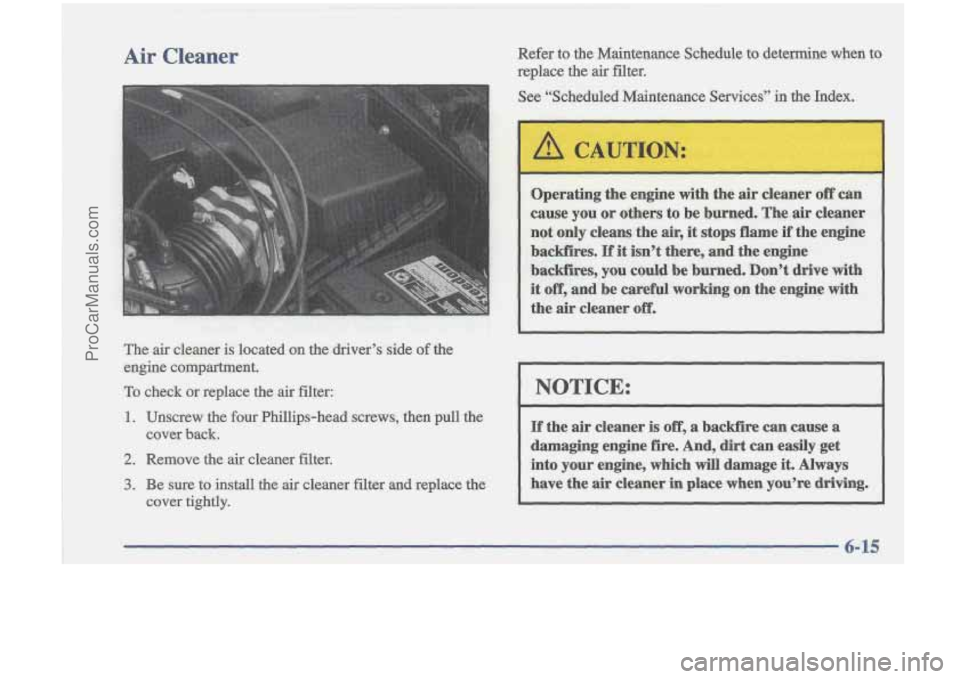
The air cleaner is located on the driver’s side of the
engine compartment.
To check
or replace the air filter:
1. Unscrew the four Phillips-head screws, then pull the
2. Remove the air cleaner filter.
3. Be sure to install the air cleaner filter and replace the
cover back.
cover tightly. Refer to the Maintenance Schedule
to determine when to
replace the air filter,
See “Sch’eduled Maintenance Services”
in the Index.
I NOTICE:
If the air cleaner is off, a backfire can cause a
damaging engine
fire. And, dirt can easily get
into your engine, which
will damage it. Always
have the air cleaner in place when you’re driving.
6-15
ProCarManuals.com
Page 239 of 353
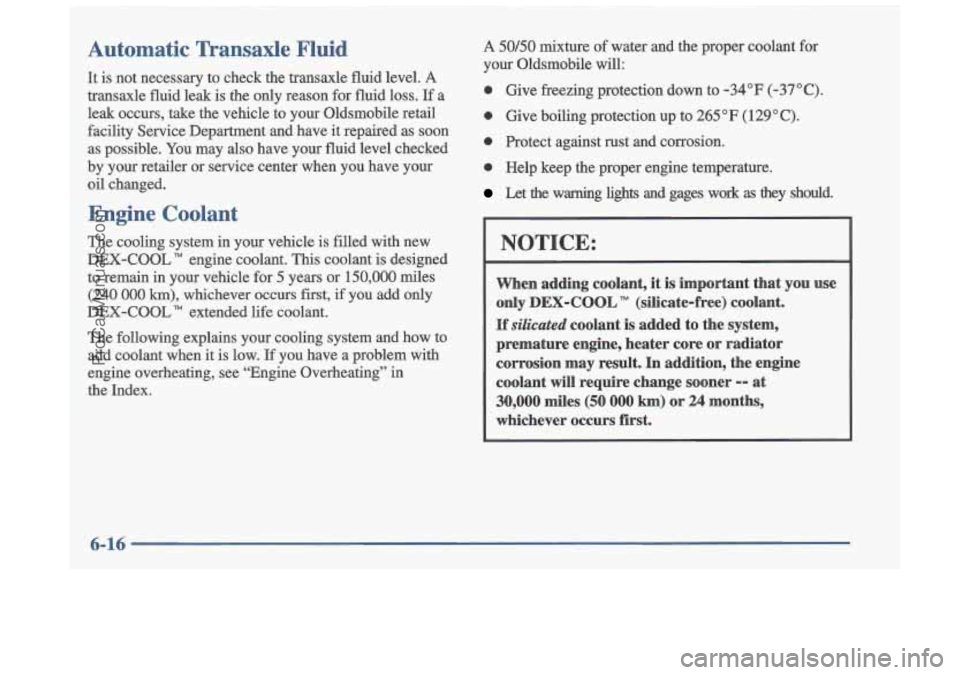
Automatic Transaxle Fluid
It is not necessary to check the transaxle fluid level. A
transaxle fluid leak is the only reason for fluid loss. If a
leak occurs, take the vehicle to your Oldsmobile retail
facility Service Department and have it repaired as soon
as possible. You may also have your fluid level checked
by your retailer or service center when you have your
oil changed.
Engine Coolant
The cooling system in your vehicle is filled with new
DEX-COOL” engine coolant.
This coolant is designed
to remain
in your vehicle for 5 years or 150,000 miles
(240 000 km), whichever occurs first, if you add only
DEX-COOL
TM extended life coolant.
The following explains your cooling system and how to
add coolant when it is low. If you have a problem with
engine overheating, see “Engine Overheating” in
the Index.
A 50/50 mixture of water and the proper coolant for
your Oldsmobile will:
0 Give freezing protection down to -34°F (-37°C).
0 Give boiling protection up to 265 “F (129 O C).
0 Protect against rust and corrosion.
0 Help keep the proper engine temperature.
Let the warning lights and gages work as they should.
NOTICE:
When adding coolant, it is important that you use
only
DEX-COOL TM (silicate-free) coolant.
If silicated coolant is added to the system,
premature engine, heater core or radiator
corrosion may result. In addition, the engine
coolant will require change sooner
-- at
30,000 miles (50 000 km) or 24 months,
whichever occurs first.
ProCarManuals.com